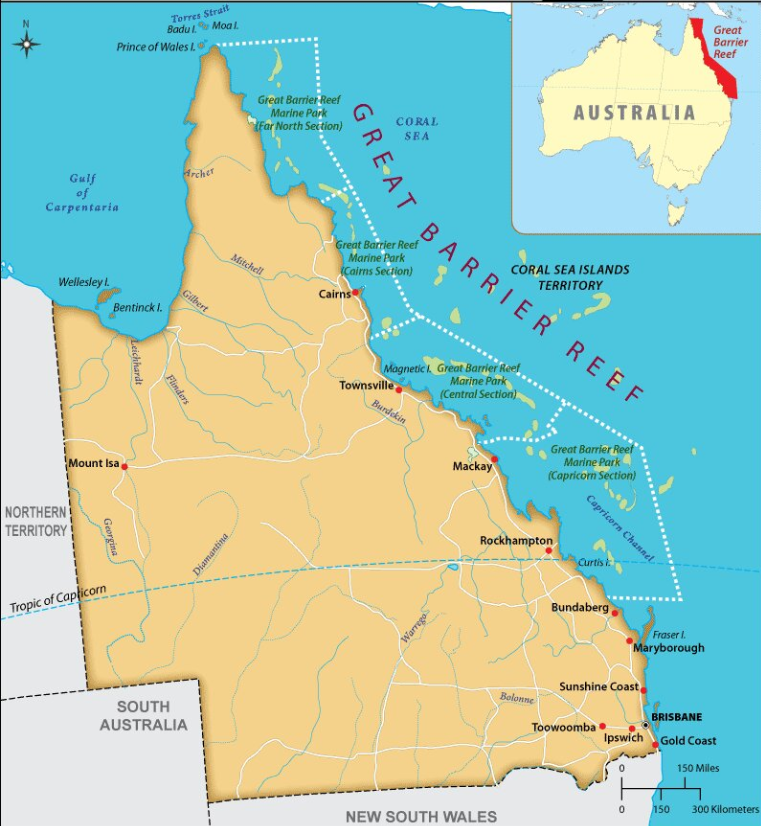Important Facts For Prelims
Warming of Great Barrier Reef Waters
- 10 Aug 2024
- 6 min read
Why in News?
Ocean temperatures in the Great Barrier Reef hit their highest level in 400 years over the past decade. The reef suffered mass coral bleaching events between 2016 and 2024.
Great Barrier Reef (GBR)
- The GBR is the world's largest coral reef system. It's located in the Coral Sea off the coast of Queensland, Australia.
- It stretches across 2,300 km and is made up of around 3,000 individual reefs and 900 islands. The GBR is home to 400 types of coral, and 1,500 species of fish.
- It's also home to endangered species such as the dugong and the large green turtle.
- The GBR is a UNESCO World Heritage site and was inscribed in 1981.
- Widespread mass bleaching of the Great Barrier Reef was first seen in 1998 and happened again in 2002, 2016, 2017, 2020, 2022 and 2024.
What are the Research Findings?
- Coral Bleaching: Aerial surveys of more than 300 reefs along Australia's northeast coast revealed bleaching in shallow waters, affecting two-thirds of the reef.
- Rising Threats: Even if global warming is kept under the Paris Agreement's goal, 70% to 90% of corals across the globe could be threatened.
- Less Diversity: Coral reefs have been evolving over the past quarter century in response to bleaching events. As more heat-tolerant coral replaces the less heat-tolerant species, there is a real concern about the expected extreme loss in the number of species and reduction in area that the world's largest reef covers.
What are Coral Reefs?
- About:
- Coral reefs are marine ecosystems primarily composed of coral polyps that form symbiotic relationships with zooxanthellae, a photosynthetic algae.
- The zooxanthellae provide corals with nutrients and oxygen, while corals offer shelter. This mutualism is vital for the health and survival of coral reefecosystems.
- Types:
- Hydrocorals (Fire Corals): They are reef-building hydroids that have a hard calcareous exoskeleton and stinging cells that can cause a burning sensation when touched.
- Octocorals (Soft Corals): It includes sea fans and sea whips, which grow more like fleshy plants and do not form calcium carbonate skeletal structures.
- Antipatharians (Black Corals): They are a type of ‘soft’ coral recognised by their jet-black or dark brown chitin skeletons.
- Geographical Extent:
- Corals can be found throughout the world’s oceans, in both shallow and deep water. However, the reef-building corals that rely on a symbiotic relationship with algae need shallow, clear water, allowing light penetration for photosynthesis.
- Stony corals also require tropical or subtropical temperatures, which exist in a band between 30° north and south latitudes.
- The major coral reef formations in India are Gulf of Mannar, Palk Bay, Gulf of Kachchh, Andaman and Nicobar Islands and Lakshadweep Islands.
- Corals can be found throughout the world’s oceans, in both shallow and deep water. However, the reef-building corals that rely on a symbiotic relationship with algae need shallow, clear water, allowing light penetration for photosynthesis.
- Importance:
- They cover only 1% of the world's oceans but provide habitat for at least 25% of the world’s marine species.
- Coral reefs are valuable for medicinal research, with many drugs being developed from reef organisms to treat cancer, arthritis, infections, and other diseases.
- Coral reefs protect shorelines by mitigating the impact of waves, storms, and floods and contribute to beach formation, with much of the sand on nearby beaches made from broken-down coral skeletons.
- Coral reefs are also home to important filter feeders, like sponges, that filter toxins and contaminants out of the oceans, and support large amounts of plant life that take in carbon dioxide and release oxygen.
- Coral Bleaching:
- When corals are stressed due to factors like increased ocean temperature orpollution, the algae leave the coral’s tissue.
- Without algae, corals lose their color, turning white or very pale, and become more vulnerable to disease.
- The loss of algae disrupts the coral's food supply and leads to coral bleaching.
UPSC Civil Services Examination, Previous Year Question (PYQ)
Prelims:
Q.Consider the following statements: (2018)
- Most of the world’s coral reefs are in tropical waters.
- More than one-third of the world’s coral reefs are located in the territories of
- Australia, Indonesia and Philippines.
- Coral reefs host far more number of animal phyla than those hosted by tropical
- rainforests.
Which of the statements given above is/are correct?
(a) 1 and 2 only
(b) 3 only
(c) 1 and 3 only
(d) 1, 2 and 3
Ans: (d)
Q.Which of the following have coral reefs? (2014)
- Andaman and Nicobar Islands
- Gulf of Kachchh
- Gulf of Mannar
- Sunderbans
Select the correct answer using the code given below:
(a) 1, 2 and 3 only
(b) 2 and 4 only
(c) 1 and 3 only
(d) 1, 2, 3 and 4
Ans: (a)









